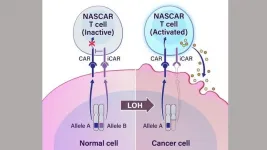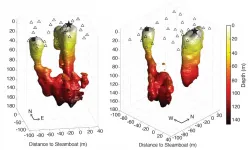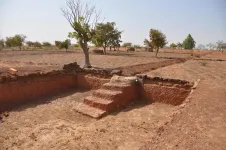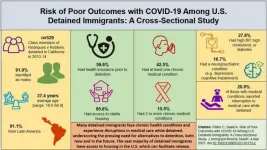(Press-News.org) If you live in a flood prone area, would you -- or could you -- take measures to mitigate flood risks? What about others in your community? We are running out of time to ask this question according to The World Resources Institute, because global flood risk is increasing and loss projections for rivers alone put the cost over 500 billion dollars by midcentury.
Research published today in Proceedings of the National Academy of Sciences from scientists from the University of Connecticut, the University of Maryland's National Socio-Environmental Synthesis Center (SESYNC), the University of Massachusetts Amherst, and the London School of Economics suggests that in the United States, race and stream flow are important indicators among the myriad factors considered in flood risk behavior.
This research started with the complexities of studying human behavior in mind, says UConn Assistant Professor James Knighton, when the researchers decided to look at a model designed to approximate how populations respond to flooding events,
"I was talking with one of my colleagues, Kelly Hondula, and we were looking critically at these models of human behavior and thinking they're too simple and there is no way they could apply to US cities. How could they be useful? Originally we were writing this paper to show that these models may only apply to community flooding dynamics in very carefully controlled case studies."
"We started with data from over 200 cities that had long records of streamflow from USGS," explains Kelly Hondula, formerly of SESYNC and currently a postdoc at Battelle's National Ecological Observatory Network. "Although the model only worked for a subset of those, we were surprised that there were so many cities where the model could explain patterns in the data quite well given how complex the interactions are between flooding, risk mitigation, and structural inequalities."
The researchers tailored the models to 50 metropolitan areas across the US at risk for river flooding events, says Knighton. "These are models where you feed in a time series of flooding hazards that happen every year. The model uses streamflow information to predict how much damage occurs in a flood, how much a given flood changes a community's behavior, and how lasting are these changes."
They further calibrated the models to include trends in behaviors related to flood insurance policies and claims.
Knighton says, "After running the model, we were totally shocked because it worked fairly well. We shifted our focus to see what this model is saying about these communities."
The models show two diverging patterns among US metro areas, one the researchers deemed 'risk enduring' where as soon as a flood occurs, incidences of people obtaining insurance policies goes up then as years progress, those policies quickly decline says Knighton. The other pattern group, they deemed 'risk averse', responds differently to a flood where a flood happens, a modest increase in the insurance policies was seen, then the levels do not drop as rapidly as seen in the risk enduring group. The next flood would see a slight increase in policies where levels would stay fairly consistent.
Professor Christian Guzman of the University of Massachusetts Amherst says the researchers were mindful in how they described the diverging patterns, "Some models have termed a certain group as 'risk-taking' (versus risk-averse), but we decided to reorient this to indicate risk-enduring populations, meaning these groups are probably enduring the risk of flooding despite risk-preference or any agency associated with these preferences. This was something we found to be important when discussing flood risks and history in the U.S."
To learn more about these communities, the researchers including Rebecca Elliot at the London School of Economics, analyzed census data for the cities to see if measurements of social vulnerability could describe the divergent patterns, which Knighton said was also immediately apparent. Socioeconomic demographics were the main split between the patterns where the proportion of white residents was higher in risk averse communities.
"Our thinking was that poverty and race may indicate socioeconomic barriers to participate in existing federal programs such as the National Flood Insurance Program (NFIP). There is probably also some aspect of this where people are rational actors in the economic systems where if they perceive a big risk they will take some sort of action to mitigate the risk and if they don't perceive a risk they won't. The National Flood Insurance Program is built around this belief," says Knighton.
The researchers started from the opposite end of the spectrum, assuming there are no social barriers to people acting as rational actors, says Knighton, "We asked, is there some component of this that is actually tied to the risks people are facing? That is why we looked at stream flow and how predictable it is for people who live near it."
This predictability can be measured with a variable called 'flashiness'. A stream that is likely to stay at roughly the same level day-to-day is less flashy, whereas flashy streams have drastic and less predictable level fluctuations.
"Overall, we saw two things," says Knighton. "Race and flashiness together were very strong predictors of insurance dynamics."
Risk averse communities also tend to have much more local investments in their flood control infrastructure, such as more and bigger dams says Knighton. There is more federal attention on larger, richer, and whiter cities.
Knighton explains that barriers such as affordability and bureaucratic red tape may make access to insurance difficult and inequitable. Accounting for all these factors led to this research being the most comprehensive model-based investigation of flood risk behaviors in the US to date. There are programs in place that are designed to make federal flood programs more accessible, however inequities remain and the researchers hope that this research will raise awareness.
"It seems like there is a very rational component to the insurance market where people have some basic understanding of hydrology and can assess their local risks and they're taking action, but there are also barriers. The barriers of race, and likely poverty, are limiting certain communities or individuals from participating."
The Federal Emergency Management Agency, FEMA, has been committed by Congress to investigate an affordability framework which would be a way for the National Flood Insurance Program to apportion flood insurance more equitably. However, action needs to be taken quickly.
"Part of our hope is that there is strong support for a comprehensive affordability framework," says Knighton. "Some cities just live with risk. Flooding will likely get worse in the near future. Maybe people are able to live with the flooding we have now but we can't know for certain if everyone can live with the flooding that is coming."
INFORMATION:
This work was supported by the National Socio-Environmental Synthesis Center (SESYNC) under funding received from the National Science Foundation DBI-1639145.
Do BMMFs, the novel infectious agents found in dairy products and bovine sera, play a role in the development of colorectal cancer? Scientists led by Harald zur Hausen detected the pathogens in colorectal cancer patients in close proximity to tumors. The researchers show that the BMMFs trigger local chronic inflammation, which can cause mutations via activated oxygen molecules and thus promote cancer development in the long term. BMMFs and inflammatory markers were significantly more frequently detectable in the vicinity of malignant intestinal tumors than in the intestinal tissue of tumor-free individuals.
A few years ago, ...
Researchers developed a prototype for a new cancer immunotherapy that uses engineered T cells to target a genetic alteration common among all cancers. The approach, which stimulates an immune response against cells that are missing one gene copy, called loss of heterozygosity (LOH), was developed by researchers at the Ludwig Center, Lustgarten Laboratory and the Bloomberg~Kimmel Institute for Cancer Immunotherapy at the Johns Hopkins Kimmel Cancer Center.
Genes have two alleles, or copies, with one copy inherited from each parent. Cancer-related genetic alterations commonly involve the loss of one of these gene copies.
"This copy loss, or LOH, is one of the most common genetic events in cancer," says Kenneth Kinzler, Ph.D., co-director of the Ludwig Center, professor of oncology and ...
HOUSTON - (March 15, 2021) - Increased internet-access spending by Texas public schools improved academic performance but also led to more disciplinary problems among students, a study of 9,000 schools conducted by a research team from Rice University, Texas A&M University and the University of Notre Dame shows.
Whether students benefit from increased internet access in public schools has been an open question, according to the researchers. For example, some parents and policy advocates contend it increases children's access to obscene or harmful content and disciplinary problems. Others believe it promotes personalized learning and higher student engagement.
To address these policy questions, the research team created a multiyear dataset (2000-14) of 1,243 school districts ...
When Steamboat Geyser, the world's tallest, started erupting again in 2018 in Yellowstone National Park after decades of relative silence, it raised a few tantalizing scientific questions. Why is it so tall? Why is it erupting again now? And what can we learn about it before it goes quiet again?
The University of Utah has been studying the geology and seismology of Yellowstone and its unique features for decades, so U scientists were ready to jump at the opportunity to get an unprecedented look at the workings of Steamboat Geyser. Their findings provide a picture of the depth of the geyser as well as a redefinition of a long-assumed relationship between the geyser and a nearby spring. The findings are published in the Journal of Geophysical Research-Solid Earth.
"We ...
If you are a consumer and/or entrepreneur who can make decisions based on cost, competition, supply and demand, you probably possess an element of marketplace literacy.
"Marketplace literacy" is defined as the knowledge and skills that enable individuals to participate in a marketplace both as consumers and entrepreneurs. San Diego State University marketing professor Nita Umashankar, along with professors Madhubalan Viswanathan (Loyola Marymount University), Arun Sreekumar (University of Illinois at Urbana Champaign) and Ashley Goreczny (Iowa State University), explored the impact on marketplace literacy on ...
HSE University researchers together with specialists from the Humanitarian Action Charitable Fund (St. Petersburg) and the University of Michigan School of Public Health (USA) studied the specifics of remote work with Russian people who use drugs to reduce the harm of drug use. They discovered that the use of online platforms increases the § who use drugs to seek help. Online platforms also serve as a kind of 'gateway' for people with problematic drug use to receive a wider range of qualified help. The authors concluded that remote work in this field should be developed and built upon in ...
Forest landscape restoration is attaining new global momentum this year under the Decade of Ecosystem Restoration (2021-2030), an initiative launched by the United Nations. Burkina Faso, in West Africa, is one country that already has a head start in forest landscape restoration, and offers valuable lessons. An assessment of achievements there and in other countries with a history of landscape restoration is critical to informing a new wave of projects aiming for more ambitious targets that are being developed thanks to renewed global interest and political will to improve the environment.
Burkina Faso has been fighting with desertification and climate change, and has seen a progressive degradation of its forested landscapes due to the expansion of agriculture. In 2018, the country ...
In the last 20 years, Black adults living in rural areas of the United States experienced high mortality rates due to diabetes, high blood pressure, heart disease and stroke compared to white adults. According to a research letter published in the Journal of the American College of Cardiology, racial disparities improved minimally in rural areas over the last two decades, with larger improvements occurring in urban areas.
"While modest gains have been made in reducing racial health inequities in urban areas, large gaps in death rates between Black and white adults persist in rural areas, particularly for diabetes and hypertension. We haven't meaningfully ...
March 15, 2021 - After arthroscopic surgery on the meniscus of the knee, patients using telemedicine for postoperative follow-up are just as satisfied with their care as those making in-person visits, reports a study in The Journal of Bone & Joint Surgery. The journal is published in the Lippincott portfolio in partnership with Wolters Kluwer.
"Patient satisfaction with overall care is equivalent between telemedicine and office-based follow-up after an arthroscopic meniscal surgical procedure in the immediate postoperative period," according to the randomized trial report by Christina P. Herrero, MD, and colleagues of NYU Langone Health, New York , and colleagues.
Telemedicine is 'a reasonable alternative' for postoperative visits
The ...
Immigrants imprisoned in immigration facilities across the country face health conditions and often have chronic illnesses that would expose them to greater risk with COVID-19, a new University of California, Davis, study suggests.
"The research is clear: immigration detention is not only unnecessary for facilitating a just immigration system, but also causes extensive harm to detained people, perhaps especially to those facing chronic health conditions," said the study's lead author, Caitlin Patler, professor of sociology. "This is particularly alarming in the context of the COVID-19 pandemic. The government must act quickly to permanently reduce reliance ...





